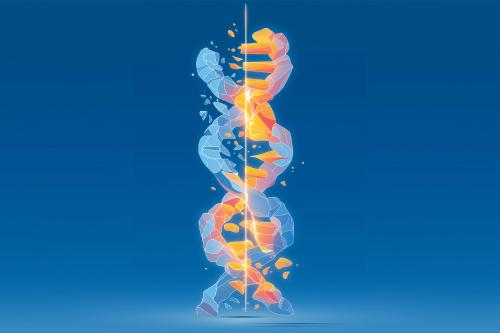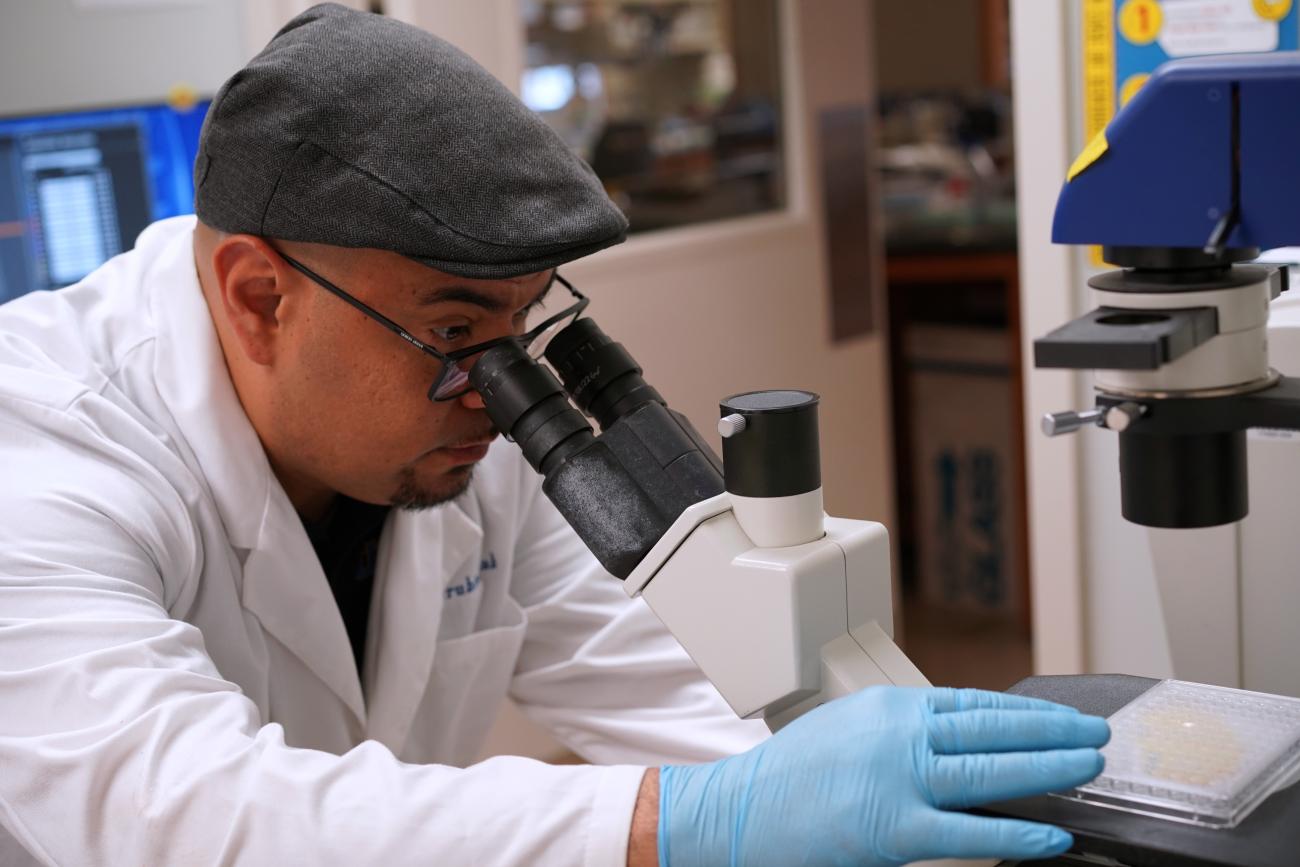
Rejuvenating our bodies through regenerative medicine
In ancient Greek mythology, the Titan Prometheus stole fire from Zeus and gifted it to humankind. Zeus took his vengeance by chaining Prometheus to a mountain and torturing him.
Every day, an eagle would swoop down to eat Prometheus’ liver. Every night, the organ would regrow in his body.
A liver growing back on its own might be the stuff of legend. But the idea of repair and replenishment underlies a modern field of medicine.
“I really think of regenerative medicine as finding ways to capitalize on the body's own ability to regenerate tissues,” said Thomas Rando, MD, PhD, director of the Eli and Edythe Broad Center of Regenerative Medicine and Stem Cell Research at UCLA.

For more than two decades, the center has hosted researchers from across scientific disciplines to study mechanisms of disease, explore new therapies to heal the body and understand how repair and regeneration may arrest aging.
That has resulted in nearly 400 patents for new therapies and technologies, 176 clinical trials and 28 startups founded by its members.
Regenerative medicine is one of the seven research themes in the David Geffen School of Medicine at UCLA.
The themes serve to break down silos between departments and foster collaborations between hundreds of scientists, laboratories and clinicians. The stem cell center is the hub of the regenerative medicine theme.
It is the body’s innate ability to renew itself that allows the continuum of life. But when that is interrupted, regenerative medicine research finds ways to restore function at the deepest cellular level.
One example: by infusing healthy blood-forming stem cells, bone marrow transplantation has provided treatment for leukemia and other conditions for decades.
Another, more recent example: With CAR T-cell therapy, a patient’s own immune cells can be modified in order to target and fight cancer cells.
But principles of regenerative medicine also offer hope to expand the body’s ability to heal – even in tissues where it naturally cannot.
For instance, the heart is an organ that cannot repair itself.
“When you have a heart attack, that part of the heart dies, and it's gone,” said Dr. Rando.
“But there are studies being done now to see if we can create new cardiac cells in a Petri dish and then transplant them into a heart.”
That’s the awe-inspiring power of regenerative medicine: in effect, to erase the marks of circumstance and time on our bodies.
Read on for highlights from some of the work being conducted under the regenerative medicine theme.
What is “inflammaging?”
It was during his biology classes at UCLA that Anthony J. Covarrubias, PhD, first learned about the role of inflammation in the immune system.
“I thought it was really fascinating that chronic inflammation can be a major driver of not just diseases like cancer and diabetes, but even the aging process,” said Dr. Covarrubias, an assistant professor of microbiology, immunology and molecular genetics at the medical school.
“I really wanted to understand how that happens and ways we can intervene.”
Dr. Covarrubias works at the intersection of inflammation and aging – inflammaging.
He focuses on cellular senescence, “when a cell stops dividing in response to some type of stress.”

Under normal conditions of repair and regeneration, senescence is beneficial. For example, by preventing damaged cells from proliferating, senescence acts as an anti-cancer mechanism.
The immune system usually clears out senescent cells. But they begin to accumulate as the body ages and clearance slows down.
This can trigger chronic inflammation, which damages healthy cells and impairs regeneration.
Ultimately, the cascading effects of these “zombie cells” can result in a range of health conditions such as diabetes, cancer and neurodegenerative diseases.
Senescent cells can also accumulate because of the choices we make in daily life: diet, exercise and sleep.
Dr. Covarrubias and his team found that putting mice on a high-fat, high-cholesterol diet drove senescence even in younger mice.
This result may be relevant to conditions like non-alcoholic fatty liver disease (NAFLD), in which fat builds up in the liver.
Dr. Covarrubias found lots of senescent cells in these inflamed livers and is exploring ways to reverse their damage.
To translate discoveries in his basic science lab, Dr. Covarrubias collaborates with clinician-scientists who see patients. Together, their work may one day lead to treatments.
That is ultimately his hope with NAFLD, which disproportionately affects the Latino community.
“We’re working on very fundamental mechanisms of disease – a disease that has a big impact on my community,” Dr. Covarrubias said. “The goal is to find interventions that you could start even at a later age and still have great benefits.”
For right now, living longer and healthier “really starts with living a healthy lifestyle,” Dr. Covarrubias said.
He tends to reflect on his research in the front yard of his home, where he grows a large variety of fruits and vegetables and collects fresh eggs every morning from his flock of chickens.

“Having this connection to my garden helps me to really appreciate having a balanced diet, knowing where my food comes from and trying to practice what I preach.”
Insurance for aging
Research into cellular senescence is like “buying insurance” for future age-related complications, said Dr. Rando, who is also a professor in the department of neurology at the medical school.
“You want to make sure that when you have a hip fracture, we can institute therapies that will help repair that hip fracture like you're a young person,” he said. “That is not what happens now.”
Nearly every medical treatment “started in the laboratory with basic science research,” Dr. Rando said.
“To think that what you're doing today has the potential to enhance the health of people 10 or 20 years from now – that's a great privilege.”
His own research examines muscle regeneration. As the body ages, stem cells are less efficient at regenerating the cells and tissues that make up skin, bone or muscle.
Dr. Rando is researching whether old stem cells can be made as effective as young stem cells, and how the regenerative power of stem cells can be harnessed in treatments.
The aim is to one day transplant stem cells to rebuild muscle – whether after injury, such as from a car accident, or as a consequence of disease, such as muscular dystrophies.
“The idea has been around for decades,” said Dr. Rando. “The trials have been very disappointing, and I think there's still a lot we don't know.”
This painstaking, methodical investigation is how research progresses – until one day, you get to a breakthrough and feel the “joy in discovering new things,” Dr. Rando said.
Lung repair
Though there may be limits to transplanting stem cells, their potential to regenerate provides a remarkable way to study the intricacies of the body’s tissues.
In a manner akin to the reappearance of Prometheus’ liver, Brigitte Gomperts, MD, is creating human lungs in her laboratory.
She isolates adult stem cells from a large biobank of lung tissues and tends to the cells as they transform into mini lung systems in Petri dishes.
These three-dimensional organoids can help model disease, the effects of toxins such as cigarette and wildfire smoke and the impact of potential treatments.
They have given Dr. Gomperts a better understanding of the respiratory system, with its complex structure composed of more than 60 different cell types.

One key aspect is her work decoding mucociliary clearance – when the viruses, bacteria and toxins that infiltrate the respiratory system are trapped by mucus and cleared from the airway by cilia.
(Of note: an organoid is far more representative than an animal model because mice produce little to no mucus in their airways.)
Lung diseases can disrupt normal functioning of clearing mucus. For example, cystic fibrosis is a life-threatening genetic disease in which thick mucus clogs the lungs.
“We all know people with chronic bronchitis where they're coughing all the time,” said Dr. Gomperts, associate director of translational research at the stem cell center, and co-director of cancer stem cell biology at the UCLA Health Jonsson Comprehensive Cancer Center.

“Maybe we could figure out a way to shut down that excess mucus production, which I think would be really helpful.”
To repair mucociliary clearance, Dr. Gomperts’ lab tested about 200 different drugs and discovered one that blocks the mucus pathway. They filed a patent – a first step on the very long road to an approved treatment in humans.
“My passion is to be able to find drugs that will really get to patients,” she said. “That's really what drives me.”
Present research leads to future treatments
Scientists in laboratories pour years into deducing the cellular mechanisms that serve as the foundation for future medicine. Yet they are only taking the first steps down into the “Valley of Death” – the long journey from basic research to innovative treatment.
“I don't think people always realize how many years of work goes into that drug they're taking,” said Dr. Rando. “That if they have a transplant, how many decades’ worth of biological research has gone into making transplantation safe and effective.
“The great innovations that are now saving lives came from 10 or 20 years ago.”
Dr. Rando also stressed the crucial support found in investments and funding – whether for regenerative medicine or other fields – that has underpinned all of this work.
“The United States is the beacon of the world for advances in biomedical research, and I think UCLA manifests that in spades,” he said.
“I would want people to see the value of what that investment turns out to be.”


